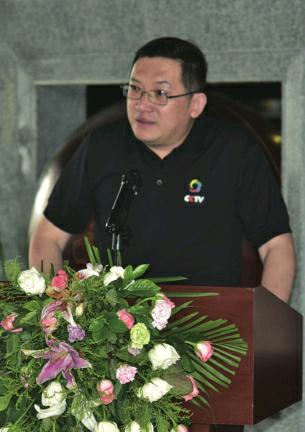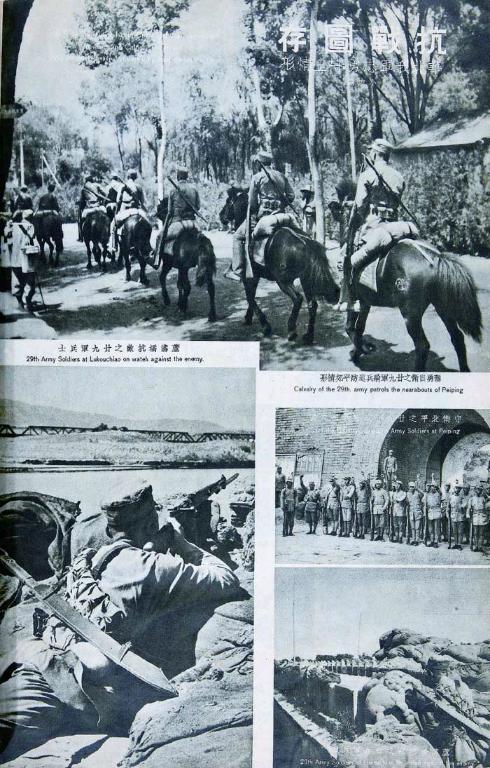Shooting Star
By+Lu+Yan
Since 1999, Feng Xuesong, a renowned documentary fi lm maker, has been on a quest.
It began with a search for a missing page in history. Or rather, a person—Fang Dazeng, a war photographer who went missing after recording the Lugou Bridge Incident. Also known as the Marco Polo Bridge Incident, the armed encounter occurred in a neighborhood of Beijing on July 7, 1937, triggering the beginning of the full-blown Chinese Peoples War of Resistance Against Japanese Aggression that lasted for nearly a decade.
As a correspondent of Ta Kung Pao, the oldest Chinese newspaper in China that is still in circulation, Fang was the fi rst journalist to report the incident from the turbulent spot. He went missing at the age of 25. Some people believe he died during the war.
“Whether Fang was killed or not, I think his story is worth telling,” Feng told Beijing Review.
Missing in action
Born in an affluent family in Peiping (todays Beijing) in July 1912 with a diplomat for his father, Fang was well educated and exposed to relatively advanced thoughts. From his childhood, he showed interest in traveling, taking photographs and writing down what he had seen.
At the beginning of the 1930s, Japan, hit by the Great Depression, invaded China to gain more resources and territory, a step in eventually pursuing world hegemony.
Though a teenager at that time, Fang decided to contribute to Chinas nationalistic struggle. He began to work for the offi cial national media and after graduating from college, began to report from the war front for Chinese and Western newspaper agencies. His reportage highlighted the lives of ordinary people, such as shepherds and miners and injured soldiers, whose lives were devastated by the ruthless war.
According to research documents published by the Chinese Academy of Social Sciences, Fang had become a famous war reporter by then, and his timely fi rst-hand reports attracted great attention.
On the night of July 7, 1937, Japanese troops stationed near Lugou Bridge in the southwest of Beijing demanded entry into nearby Wanping County on the pretext of searching for a missing soldier.
The Chinese military rejected the order and in retaliation, the Japanese bombed the county seat and the bridge. Historians regard the attack as the beginning of Japans full-scale invasion of China, though Japan had invaded northeast China in September 1931.
Hearing the news, Fang rushed to the bridge and began reporting the offensive. His last known report The Change of the Northern Section of Pinghan Line was from Lixian, a county in Hebei Province, on September 18, 1937. It was also when he disappeared.
Although his whereabouts have remained a mystery till now, Fang left behind more than 800 rolls of film of the war, which are of immense value for war studies and for people to gain a better understanding of what really happened at that time.
Lost and found
Fengs interest in the almost forgotten war photographer was stoked when he chanced upon a fax by Chen Shen, a photographic history scholar, asking for help to compile a book on Fangs work. It was the fi rst time Feng had heard of Fang.
Intrigued by the missing mans story, Feng started his search for Fang. His documentary made during the pursuit—Looking for Fang Dazeng—won a national award.
But his quest didnt stop there. After the documentary was screened in 2000, he continued the search. In the 18 years since he began the mission, Feng visited Baoding and Shijiazhuang of Hebei, and Taiyuan and Datong of Shanxi Province, where Fang had been active, several times, searching for historical materials. He interviewed hundreds of people, updated the documentary script, and wrote a book on Fangs life and infl uence.
This year, Fang would have been 105. It also marks the 80th anniversary of the Lugou Bridge Incident. In July, Fengs book—Fang Dazeng: Disappearance and Reappearance—was republished by New World Press. The royalty proceeds go to continue the search for the missing man, who has also become a war icon.
Feng hopes young people in China will look up to Fang as a role model, like he does. He thinks its a shame that many people, like war heroes, scientists and littérateurs who have contributed to the nations development, havent received their due or have even been forgotten, while a pop star or a movie star attracts widespread attention from youngsters today even when they cough.
Feng has been invited to universities, companies and other organizations at home and abroad to give lectures about Fangs life, his spirit and his influence. Many people, who hadnt heard of Fang before, were deeply touched after listening to Fengs lectures, calling the missing photographer a hero.
In his introduction to Fengs lecture at the State University of New Yorks College of Optometry in May, Guilherme Albieri, Dean of the Confucius Institute at the college, said Fang and Feng were both heroes of different times.
“Fang went to the war front immediately without hesitation, using his camera to record history, while Feng walked thousands of miles to search for Fang and bring us Fangs inspiring stories, letting us know the heros notable acts. Both are admirable,” Albieri said.
However, there are some who dont understand why Feng spends so much time and money on the search. Once he encountered a person who accused him of being a swindler who just wanted to sell his book. But the detractor was won over after listening to one of Fengs lectures.
Although Feng hasnt found out if Fang was killed by the enemy in the war, he thinks his ef- forts have not been in vain. “Now the purpose is not fi nding him, but to discover his spirit and his essence, which are eternal. In that sense, Ive already found him,” he said.

